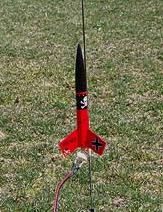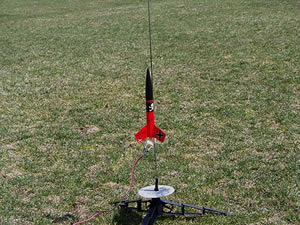Welcome
Welcome to RocketReviews.com (formerly EMRR).
RocketReviews.com is the home of almost 5000 reviews of rocketry kits and products. Written by visitors to RocketReviews.com like you, the reviews cover everything from low-power model rocket kits to high-power rocket motors.
The site's Flight Log allows you to record and share your rockets and their flights. The Builds feature helps you document your rocketry projects.
At RocketReviews.com, you'll also find a large collection of rocketry resources such as a list of rocketry clubs, and large libraries of OpenRocket design files and Rocksim design files. A number of rocketry tools and calculators are available to help you design, build, and fly your rockets.
As you explore RocketReviews.com, you'll also find a number of fun things such as a huge library of rocketry videos and a collection of photo albums.
 |
 |
Featured Review
Estes Mini Max
Manufacturer: Estes Diameter: 0.9800 inches Length: 9.7500 inches Skill Level: 1 Style: Sport
Construction Rating: 




Flight Rating: 




Overall Rating: 




Contributed by Jason Orosco

Brief:
The Mini Max is a single stage 13mm rocket with a streamer used for recovery. It's the baby
brother to the Der Red Max.
Construction:
- 1 Engine Mount Tube BT-5 1.75"
- 1 Mini Engine Hook
- 1 Mylar Hook Retainer HR-5
- 1 EB-5
- 1 CR-520 Split Ring
- 1 CR-520 Ring
- 3 Laser Cut Fins
- 1 Launch Lug 1.5"
- 1 Screw Eye
- 1 BNC-50AH
- 1 Shock cord 13"
- 1 Streamer 1.25"x17"
Basic Estes Instructions well written and the fin marking guide and shock chord mount are included in the instructions you need to cut out.
 I started with laser cut fins sanding both sides of the sheet and cutting them out, sanding the leading
edge. The fins are nice a sturdy. The engine mount was the next process. It is a nice sturdy engine mount tube and not
one of those flimsy blue tubes.
I started with laser cut fins sanding both sides of the sheet and cutting them out, sanding the leading
edge. The fins are nice a sturdy. The engine mount was the next process. It is a nice sturdy engine mount tube and not
one of those flimsy blue tubes.
The nice sturdy laser cut center rings not the flimsy ones that in passing look like they have been hit with a
punch. The next process was cutting out the tube marking guide from the instructions, wrapping it around the body tube
and then marking the lines on the tube. I used wood glue to attach the fins to the body tube. While that
 was drying,
I cut out the shock chord mount and assembled that. That was glued in after the fins had dried. Next was the launch
lug, which was glued to the body tube with white glue.
was drying,
I cut out the shock chord mount and assembled that. That was glued in after the fins had dried. Next was the launch
lug, which was glued to the body tube with white glue.
The next step was a dry test fit of the engine mount into the body. It was a nice fit without having to sand the center rings. I put a bead of white glue inside the body and engine was inserted and left to dry. Next was the screw eye which was centered into the nose cone after being sanded smooth.
I added a drop of glue in the hole to keep the screw eye from pulling out during ejection charge. The base of the nose cone needed a little sanding to get a nice snug fit. The last phase was apply a fillet of glue to the fins and launch lug and attach the streamer to the shock cord with masking tape .

Finishing:
Finishing the Mini Max was easy. I applied 2 coats of sanding sealer to the fins and nose
cone, letting the coats dry between. I then applied a 3rd coat and let it dry with a final sanding of the fins and nose
cone. After wiping down with a tact cloth, I applied a coat of Rustoleum White primer and let it dry, sanding between
coats. After wiping with tact cloth, I applied a coat of Valspar Gloss Black paint, again letting it dry between the
two coats. For the body tube and fins, they were painted using Valspar Gloss Red Paint and letting dry between the two
coats. After drying for two days, I applied the decals letting them dry overnight. I then applied a light coat of
Future floor finish to protect the decals. This provided a nice glossy finish and the decals were easy to apply.
Construction Rating: 5 out of 5
Flight:
The first 2 flights were on Estes 1/2A3-2T motors. Both were nice low flights and easy to
track. The last two flights of the day were on Estes A10-3 motors and nice high flights, but easy to track.


Recovery:
All flights were good and streamer fully deployed fine. On one of A10-3 flights I didn't add
enough wadding and scorched the nose cone. I just need to sand and reapply a coat of paint.
Flight Rating: 5 out of 5
Summary:
This is a great rocket. It seems Estes is moving in the right direction going with the sturdy
laser cut fins and center rings. Also, it's nice to have a sturdy engine mount tube instead of the flimsy blue tube,
Nice hard wood BNC that holds up well.
Overall Rating: 5 out of 5
Browse our database of about 4,300 reviews of rocketry kits and other products.
Sponsored Ads
 |
 |












